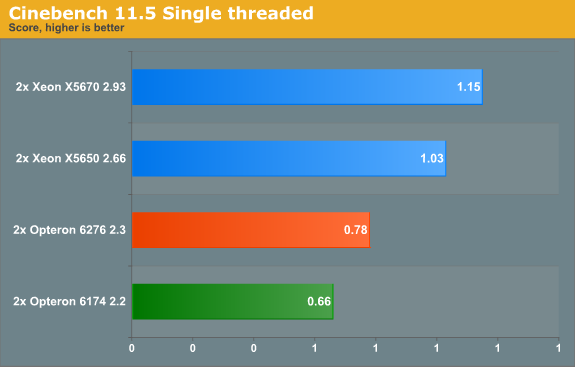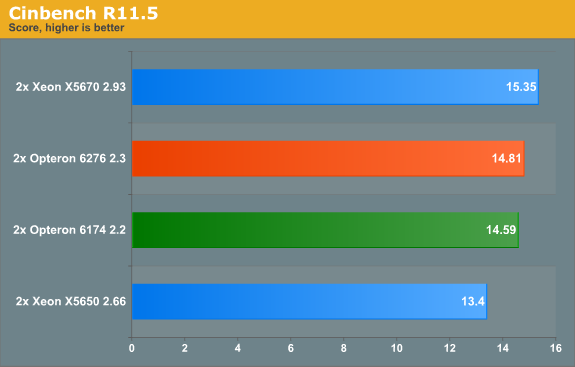Bulldozer for Servers: Testing AMD's "Interlagos" Opteron 6200 Series
by Johan De Gelas on November 15, 2011 5:09 PM ESTRendering Performance: Cinebench
Cinebench, based on MAXON's software CINEMA 4D, is probably one of the most popular benchmarks around, and it is pretty easy to perform this benchmark on your own home machine. The benchmark supports 64 threads, more than enough for our 24- and 32-thread test servers. First we tested single-threaded performance, to evaluate the performance of each core.

Single-threaded performance is relatively poor when you do not enable Turbo Core: with that setting the Opteron 6276 scores only 0.57. So the single-threaded FP performance is about 10% lower, probably a result of the higher FP/SSE latencies of the Interlagos FPU. However, the 6276 Opteron can boost the clock speed to 3.2GHz. This 39% clock speed boost leads to a 37% (!) performance boost. The difference with the older "Istanbul" based Opteron "Magny-cours" 61xx can only get larger once software with support for the powerful FMAC and AVX capable units is available. Also newer compilers will take the longer FP latencies into account and will probably boost performance by a few percent even without using FMAC or AVX.
Before we look at the Multi-threaded benchmark, Andreas Stiller, the legendary German C't Journalist ("Processor Whispers") sent me this comment:
"You should be aware that Cinebench 11.5 is using Intel openMP (libguide40.dll), which does not support AMD-NUMA"
So while Cinebench is a valid bench as quite a few people use the Intel OpenMP libraries, it is not representative of all render engines. In fact, Cinebench probably only represent the smaller part of the market that uses the Intel OpenMP API. On dual CPU systems, the Opteron machines run a bit slower than they should; on quad CPU systems, this lack of "AMD NUMA" awareness will have a larger impact.

We did not expect that the latest Opteron would outperform the previous one by a large margin. Cinebench is limited by SSE processing power. The ICC 11.0 compiler was the fastest compiler of its time for SSE/FP intensive software, even for the Opterons (up to 24% faster than the competing compilers), but it has no knowledge of newer architectures. And of course, the intel compiler does favor the Xeons.
The Opteron 6200 has a total of eight dual issue (if you count only those pipes that do calculations) FPUs, while the Opteron 6100 has a total of 12 dual issue FPUs. The only advantage that the 6200 has (if you do not use the FMAC or AVX capabilities) is that it can interleave two FP threads on one module. So you get 16 FP threads that can dispatch one FP per clock versus 12 FP threads that can dispatch two FP per clock. That capability is especially handy when your threads are blocked by memory accesses. This is hardly the case in Cinebench (but it is probably the reason why Interlagos does so well in some HPC tests) and as a result, the Opteron 6276 cannot pull away from the Opteron 6174.
Anand reported that the best Core i7 (2600K, 4 cores/8 threads, 3.4GHz) achieves 6.86. So considering that a dual Opteron 6200 is cheaper than the dual Xeon, and more manageable than two workstations, such a renderfarm may make some sense.










106 Comments
View All Comments
Kevin G - Tuesday, November 15, 2011 - link
I'm curious if CPU-Z polls the hardware for this information or if it queries a database to fetch this information. If it is getting the core and thread count from hardware, it maybe configurable. So while the chip itself does not use Hyperthreading, it maybe reporting to the OS that does it by default. This would have an impact in performance scaling as well as power consumption as load increases.MrSpadge - Tuesday, November 15, 2011 - link
They are integer cores, which share few ressources besides the FPU. On the Intel side there are two threads running concurrently (always, @Stuka87) which share a few less ressources.Arguing which one deserves the name "core" and which one doesn't is almost a moot point. However, both designs are nto that different regarding integer workloads. They're just using a different amount of shared ressources.
People should also keep in mind that a core does not neccessaril equal a core. Each Bulldozer core (or half module) is actually weaker than in Athlon 64 designs. It got some improvements but lost in some other areas. On the other hand Intels current integer cores are quite strong and fat - and it's much easier to share ressources (between 2 hyperthreaded treads) if you've got a lot of them.
MrS
leexgx - Wednesday, November 16, 2011 - link
but on Intel side there are only 4 real cores with HT off or on (on an i7 920 seems to give an benefit, but on results for the second gen 2600k HT seems less important)where as on amd there are 4 cores with each core having 2 FP in them (desktop cpu) issue is the FPs are 10-30% slower then an Phenom cpu clocked at the same speed
anglesmith - Tuesday, November 15, 2011 - link
which version of windows 2008 R2 SP1 x64 was used enterprise/datacenter/standard?Lord 666 - Tuesday, November 15, 2011 - link
People who are purchasing SB-E will be doing similar stuff on workstations. Where are those numbers?Kevin G - Tuesday, November 15, 2011 - link
Probably waiting in the pipeline for SB-E base Xeons. Socket LGA-2011 based Xeon's are still several months away.Sabresiberian - Tuesday, November 15, 2011 - link
I'm not so sure I'd fault AMD too much because 95% of the people that their product users, in this case, won't go through the effort of upgrading their software to get a significant performance increase, at least at first. Sometimes, you have to "force" people to get out of their rut and use something that's actually better for them.I freely admit that I don't know much about running business apps; I build gaming computers for personal use. I can't help but think of my Father though, complaining about Vista and Win 7 and how they won't run his old, freeware apps properly. Hey, Dad, get the people that wrote those apps to upgrade them, won't you? It's not Microsoft's fault that they won't bring them up to date.
Backwards compatibility can be a stone around the neck of progress.
I've tended to be disappointed in AMD's recent CPU releases as well, but maybe they really do have an eye focused on the future that will bring better things for us all. If that's the case, though, they need to prove it now, and stop releasing biased press reports that don't hold up when these things are benched outside of their labs.
;)
JohanAnandtech - Tuesday, November 15, 2011 - link
The problem is that a lot of server folks buy new servers to run the current or older software faster. It is a matter of TCO: they have invested a lot of work into getting webapplication x.xx to work optimally with interface y.yy and database zz.z. The vendor wants to offer a service, not a the latest technology. Only if the service gets added value from the newest technology they might consider upgrading.And you should tell your dad to run his old software in virtual box :-).
Sabresiberian - Wednesday, November 16, 2011 - link
Ah I hadn't thought of it in terms of services, which is obvious now that you say it. Thanks for educating me!;)
IlllI - Tuesday, November 15, 2011 - link
amd was shooting to capture 25% of the market? (this was like when the first amd64 chips came out)